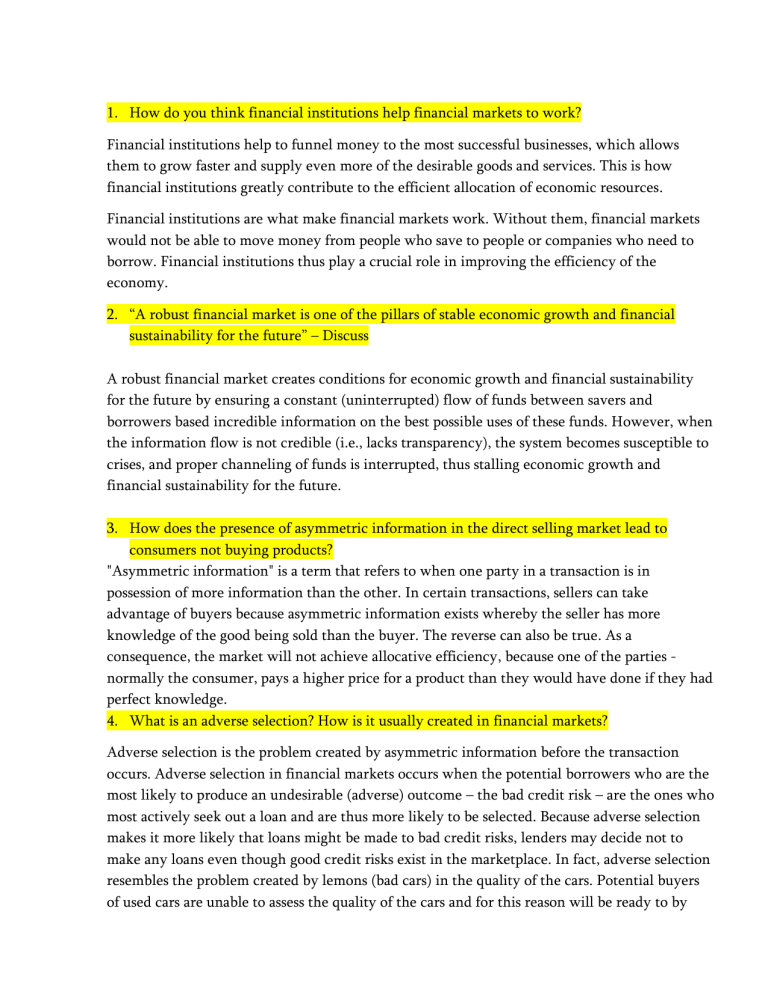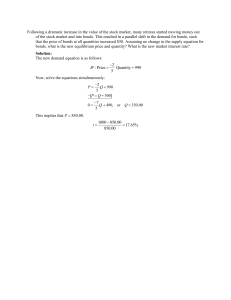
1. How do you think financial institutions help financial markets to work? Financial institutions help to funnel money to the most successful businesses, which allows them to grow faster and supply even more of the desirable goods and services. This is how financial institutions greatly contribute to the efficient allocation of economic resources. Financial institutions are what make financial markets work. Without them, financial markets would not be able to move money from people who save to people or companies who need to borrow. Financial institutions thus play a crucial role in improving the efficiency of the economy. 2. “A robust financial market is one of the pillars of stable economic growth and financial sustainability for the future” – Discuss A robust financial market creates conditions for economic growth and financial sustainability for the future by ensuring a constant (uninterrupted) flow of funds between savers and borrowers based incredible information on the best possible uses of these funds. However, when the information flow is not credible (i.e., lacks transparency), the system becomes susceptible to crises, and proper channeling of funds is interrupted, thus stalling economic growth and financial sustainability for the future. 3. How does the presence of asymmetric information in the direct selling market lead to consumers not buying products? "Asymmetric information" is a term that refers to when one party in a transaction is in possession of more information than the other. In certain transactions, sellers can take advantage of buyers because asymmetric information exists whereby the seller has more knowledge of the good being sold than the buyer. The reverse can also be true. As a consequence, the market will not achieve allocative efficiency, because one of the parties normally the consumer, pays a higher price for a product than they would have done if they had perfect knowledge. 4. What is an adverse selection? How is it usually created in financial markets? Adverse selection is the problem created by asymmetric information before the transaction occurs. Adverse selection in financial markets occurs when the potential borrowers who are the most likely to produce an undesirable (adverse) outcome – the bad credit risk – are the ones who most actively seek out a loan and are thus more likely to be selected. Because adverse selection makes it more likely that loans might be made to bad credit risks, lenders may decide not to make any loans even though good credit risks exist in the marketplace. In fact, adverse selection resembles the problem created by lemons (bad cars) in the quality of the cars. Potential buyers of used cars are unable to assess the quality of the cars and for this reason will be ready to by only a price that reflects the average quality of the cars in the market. The owners of cars, on the contrary, know the quality of the cars they own, so if they are lemons they will be still happy to sell at an average price, while if they are peaches (good cars) they know the price undervalues the car and will be reluctant to buy. This produces an economic inefficiency in the market. 5. Suppose you bought a land that costs $500,000 today. You will need to continue to pay tax on the land, and the rate is 3% of your purchase. Calculate the PV of your payment, using a 10% discount rate. Assume that there are no changes in the land’s price and tax rate. Yearly payment will be 500,000 * 3% = 15,000. Present value of future payments is 15,000/0.10 = 150,000 (a perpetuity) 6. Suppose that you want to take out a loan at a bank that wants to charge you an annual real interest rate equal to 5%. Assuming that the expected rate of inflation during the life of the loan is 2%, what will be the nominal interest rate that the bank will charge you? If the real inflation was 3% instead of the expected 2%, what was the actual real interest rate on the loan? FISHER :(Nominal interest rate=real interest rate+expected inflation) Since the bank wants to charge an annual real interest rate of 5%, and the expected rate of inflation is 2%, according to the Fisher formula, the nominal interest rate will be 5% + 2% = 7%; If the real inflation was 3%, and the nominal interest rate on the loans was 7%, using the same formula, the real interest rate is 7% - 3% = 4%. Therefore, the bank received 4% rather than 5% on your loan. 7. In the aftermath of the global economic crisis that started to take hold in 2008, U.S. government budget deficits increased dramatically, yet interest rates on U.S. Treasury debt fell sharply and stayed low for quite some time. Does this make sense? Why or why not? The supply effect of large deficits should lead to higher interest rates. The effects of the economic crisis lead to significantly lower wealth and income, which depressed Treasury bond demand, but also decreased corporate bond supply by even more because investment opportunities collapsed. The larger leftward shift in the bond supply curve than the rightward shift in the bond demand curve would then result in a rise in bond prices and a fall in interest rates. In addition, due to the severity of the global crisis, U.S. treasury debt became a safe haven investment, reducing relative risk and increasing liquidity for U.S. treasury debt. This significantly raised U.S. treasury bond demand, leading to higher bond prices and significantly lower yields. In other words, the decrease in investment opportunities and risk factors significantly offset the wealth effect on demand and the deficit effect on supply. 8. How would the demand curve for corporate bonds be affected if news about accounting scandals in major corporations spread? What would be the effect on interest rates? When news about accounting scandals in big corporations spread, people get worried about the quality of the bonds they are either holding or considering to buy. We can expect then that bonds are not as desirable assets as they were before (maybe because the ability of corporations to honor their commitments was overstated). This negatively affects demand for these bonds and shifts the demand curve to the left, raising interest rates and lowering corporate bond's prices (for a given supply curve). 9. If the current interest rate on one-year bonds is 6%, you may expect an increase in interest rates by 1% in the following year. Predict what interest rate would be suitable now for twoyear bonds. Explain your answer and state the theory that justifies it? If the current interest rate on one-year bonds is 6%, and it is expected to rise by 1% in the following year, it will become 7%. Accordingly, the current two-year bonds must have an interest rate of (6% + 7%)/2 = 6.5%. This calculation is based on the expectation theory, which states that interest rates with different maturities move together over time and longterm rates are the average of expected future short-term rates. 10. If the income tax exemption on municipal bonds were abolished, what would happen to the interest rates on these bonds? What effect would it have on interest rates on U.S. Treasury securities? Abolishing the tax-exempt feature of municipal bonds would make them less desirable relative to Treasury bonds. The resulting decline in the demand for municipal bonds and increase in demand for Treasury bonds would raise the interest rates on municipal bonds, while the interest rates on Treasury bonds would fall. 11. “The more collateral there is backing a loan, the less the lender has to worry about adverse selection.” Is this statement true, false, or uncertain? Explain your answer. True. When an individual has a lot of collateral on a loan, the more he will act in the lenders favor because he has much at risk too. 12. How does the free-rider problem aggravate adverse selection and moral hazard problems in finacial markets? Adverse Selection - Stock Market; Purchasing information to better yourself on your investment that a private company provides will cost a lot of money. That cost will be given freely to many others that follow your lead. Moral Hazard - Security Market; Spending time and money monitoring the business. Other people will no and allow you to do all the monitoring, while they sit back and save that monitoring money. 13. Provide one argument in favor of and one against the idea the Fed was responsible for the housing price bubble of the mid-2000s. There is an argument that the low fed funds rate, led to mortgage rates that stimulated housing demand and issuance of subprime mortgages. An argument against would be because of new mortgage products that lowered mortgage payments 14. Deregulation of the financial services industry in the United States and the United Kingdom led to the global financial crisis of 2007. Discuss. Deregulation in the financial industry was the primary cause of the 2008 financial crash. It allowed speculation on derivatives backed by cheap, wantonly-issued mortgages, available to even those with questionable creditworthiness. The 2007-2009 financial crisis began years earlier with cheap credit and lax lending standards that fueled a housing bubble. When the bubble burst, financial institutions were left holding trillions of dollars worth of near-worthless investments in subprime mortgages. Millions of American homeowners found themselves owing more on their mortgages than their homes were worth. The Great Recession that followed cost many their jobs, their savings, or their homes. The turnaround began in early 2009 after the passage of the infamous Wall Street bailout kept the banks operating and slowly restarted the economy.


